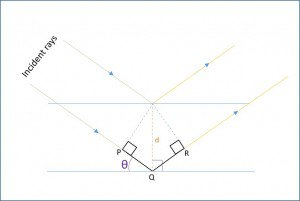This set of Materials Science Multiple Choice Questions & Answers (MCQs) focuses on “Bragg’s Law”.
1. X-rays have larger wavelengths than which of the following?
a) Gamma rays
b) Beta rays
c) Microwave
d) Visible light
View answer
Explanation: Larger wavelengths mean less energy. Only gamma rays have higher energy (or shorter wavelengths) than x-rays. Beta rays are actually streaming of particles and have much less energy than x-rays.
2. X-ray diffraction patterns are used for studying crystal structure of solids because
a) They have very high energy, hence they can penetrate through solids
b) They are electromagnetic radiation, and hence do not interact with matter (crystals)
c) Their wavelengths are comparable to inter-atomic distances
d) Their high frequency enables rapid analysis
View answer
Explanation: For diffraction to occur, the obstacle size should be comparable to the wavelength of the incident radiation.
3. For destructive interference to take place, the path difference between the two waves should be:
a) nλ
b) 2nλ
c) (n + 1/2)λ
d) (2n + 1)λ
View answer
Explanation: Constructive interference occurs when the phase difference between two interfering waves is an integral multiple of 2π. Also, the ratio of path difference to wavelength equals that of phase difference to 2π.
4. Bragg’s law is not a sufficient condition for diffraction by crystalline solids.
a) True
b) False
View answer
Explanation: Atoms present at non-corner positions may result in out-of-phase scattering at Bragg angles.
5. The Miller indices h, k, and l of parallel planes in a BCC lattice should satisfy which of the following X-ray diffraction reflection rules?
a) h + k + l should be even
b) h, k, and l should all be either even or odd
c) h, k, and l should form Pythagoras triplet
d) all planes allow reflections
View answer
Explanation: If the sum of Miller indices becomes odd for a BCC lattice, destructive interference occurs.
6. Minimum interplanar spacing required for Bragg’s diffraction is:
a) λ/4
b) λ/2
c) λ
d) 2λ
View answer
Explanation: Maximum value of incident angle can be 90° for which sine is 1. Hence d = λ/2 ( nλ = 2.d.sinθ)
7. Laue’s model pictures XRD as reflection from parallel crystalline planes. Reflection is different from refraction as:
a) diffraction occurs throughout the bulk
b) intensity of diffracted beams is less
c) diffraction in crystals occurs only at Bragg’s angles
d) all of the mentioned
View answer
Explanation: Reflection is a surface phenomenon, and large portions of the incident waves can be reflected. Moreover, reflection can occur at any angle of incidence whereas diffraction patterns (alternative dark and bright bands) occur only at Bragg’s angles.
8. In Bragg’s equation [nλ = 2.d.sinθ], θ is the angle between:
a) specimen surface and incident rays
b) normal to specimen surface and incident rays
c) parallel lattice surfaces d distance apart and incident rays
d) normal to parallel lattice surfaces d distance apart and incident rays
View answer
Explanation: In the following figure, one can easily deduce that the path difference (PQ + QR) between the two incident waves is 2.d.sinθ using simple trigonometry.

9. In the powder method of XRD, the intensities of various bright lines are compared to determine the crystal structure. For simple cubic lattice the ratio of intensities at first two maxima are:
a) 1⁄2
b) 3⁄4
c) 1⁄2
d) None of the mentioned
View answer
Explanation: For simple cubic lattice, the intensities at subsequent maxima are in the ratio 1:2:3:4:5:6:8
10. K-alpha x-rays have shorter wavelengths than K-beta x-rays?
a) True
b) False
View answer
Explanation: K-alpha is formed from a transfer of electrons from L shell to K while K-beta result from M-to-K transition. Hence K-alpha lines have lower energy (or longer wavelength).
Sanfoundry Global Education & Learning Series – Materials Science.
To practice all areas of Materials Science, here is complete set of 1000+ Multiple Choice Questions and Answers.
If you find a mistake in question / option / answer, kindly take a screenshot and email to [email protected]
